Module 4 Healthy food Unit 3 Language in use习题课件
文档属性
| 名称 | Module 4 Healthy food Unit 3 Language in use习题课件 | 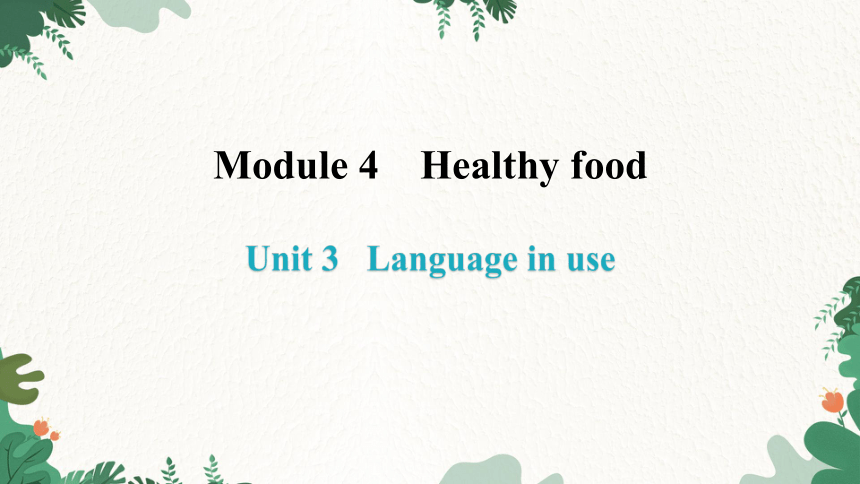 | |
| 格式 | pptx | ||
| 文件大小 | 2.3MB | ||
| 资源类型 | 教案 | ||
| 版本资源 | 外研版 | ||
| 科目 | 英语 | ||
| 更新时间 | 2022-08-15 08:27:54 | ||
图片预览


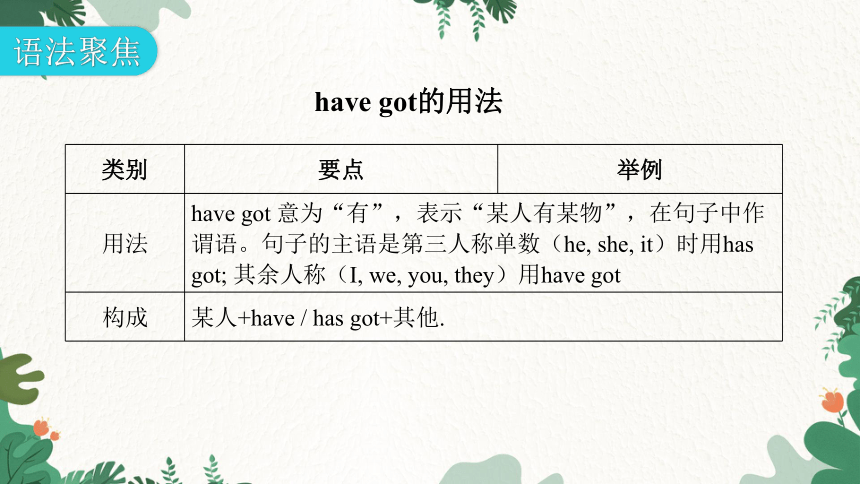


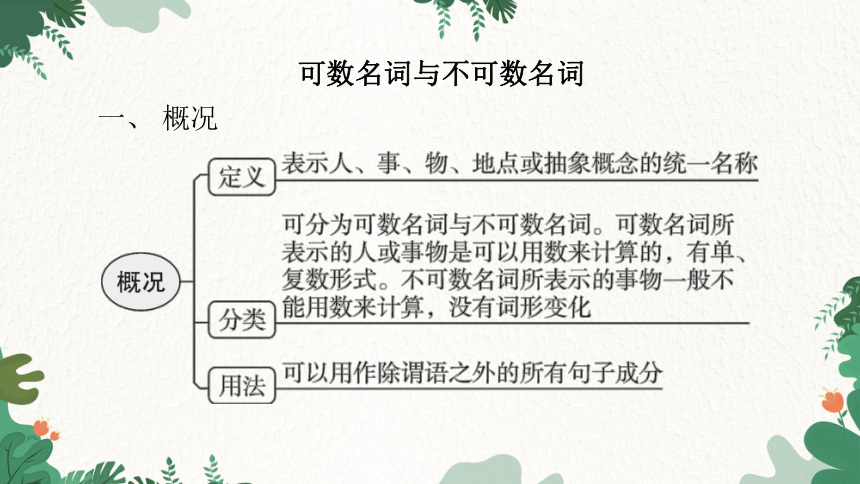
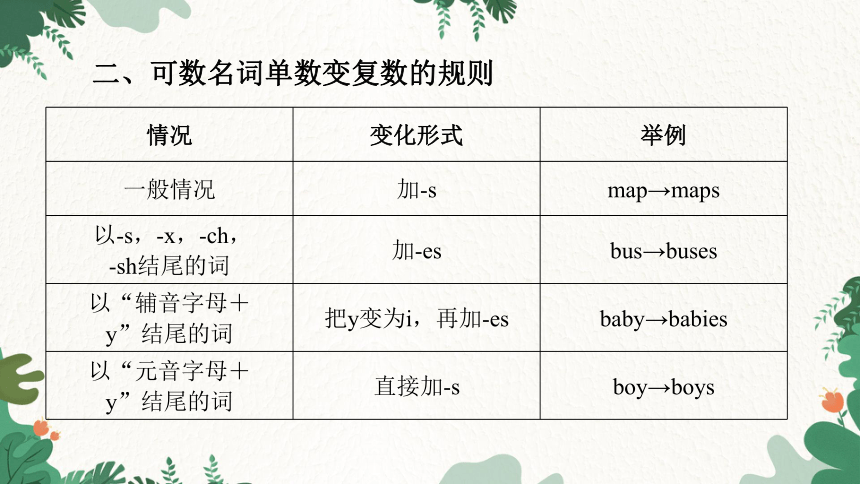

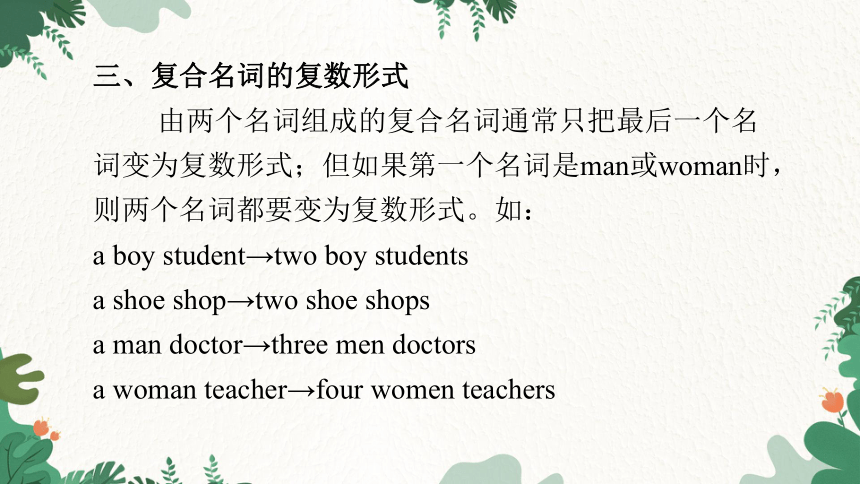
文档简介
(共28张PPT)
Module 4 Healthy food
Unit 3 Language in use
目录
01
语法聚焦
02
课堂小测
03
课后作业
语法聚焦
have got的用法
类别 要点 举例
用法 have got 意为“有”,表示“某人有某物”,在句子中作谓语。句子的主语是第三人称单数(he, she, it)时用has got; 其余人称(I, we, you, they)用have got
构成 某人+have / has got+其他.
类别 要点 举例
句式 肯定句:某人+have / has got+其他. He / She has got a new coat. 他 / 她有一件新外套。
You / We / They / I have got a computer. 你(们)/ 我们 / 他们 / 我有一台电脑。
否定句:某人+have not(haven't) / has not(hasn't)got+其他. He / She hasn't got a new coat. 他 / 她没有一件新外套。
You / We / They / I haven't got a computer.你(们)/ 我们 / 他们 / 我没有电脑。
类别 要点 举例
句式 一般疑问句:Have / Has+某人+got+其他? 肯定回答: Yes, 主语+have / has. 否定回答: No, 主语+haven't / hasn't. —Has Mary got any meat 玛丽有肉吗?
—Yes,she has. / No,she hasn't. 是的,她有。 / 不,她没有。
—Have Mary and Tom got computers 玛丽和汤姆有电脑吗?
—Yes, they have. / No, they haven't. 是的,他们有。 / 不,他们没有。
可数名词与不可数名词
一、 概况
二、可数名词单数变复数的规则
情况 变化形式 举例
一般情况 加-s map→maps
以-s,-x,-ch, -sh结尾的词 加-es bus→buses
以“辅音字母+ y”结尾的词 把y变为i,再加-es baby→babies
以“元音字母+ y”结尾的词 直接加-s boy→boys
情况 变化形式 举例
以o结尾的词 无生命的名词一般直接加-s zoo→zoos
有生命的名词加-es potato→potatoes,
hero→heroes
以-f或 -fe 结尾的词 把f或fe变为v, 再加-es leaf→leaves
不规则变化 (需单独记忆) sheep→sheep, Chinese→Chinese, foot→feet, tooth→teeth, man→men, woman→women, child→children
三、复合名词的复数形式
由两个名词组成的复合名词通常只把最后一个名词变为复数形式;但如果第一个名词是man或woman时,则两个名词都要变为复数形式。如:
a boy student→two boy students
a shoe shop→two shoe shops
a man doctor→three men doctors
a woman teacher→four women teachers
四、可数名词与不可数名词的用法区别
1. 可数名词单数可用a或an来修饰,而不可数名词的量则要借助一个量词来表达,其结构为“数词+量词+of+不可数名词”。如:a cup of tea, two pieces of paper。
2. 可数名词复数可以用具体的数词来修饰,还可以用some, many, a lot of / lots of, a few, few等来表达数量的多少。如:some pens等。
不可数名词前不能直接加数词,但可用some, much, a lot of / lots of, little, a little等来修饰。如: some money, much rice, a little water等。
3. 可数名词常用how many来询问数量的多少,不可数名词的数量则用how much提问。如:
How many eggs have we got 我们有多少鸡蛋? How much meat have they got 他们有多少肉?
五、有些不可数名词也可作可数名词或者动词
How much orange is there in the bottle 瓶子里有多少橙汁?(orange作“橙汁”,为不可数名词)
How many oranges are there on the table 桌子上有多少个橙子?(oranges意为“橙子”,为可数名词)
I like eating fish.我喜欢吃鱼(肉)。(fish意为“鱼肉”,作不可数名词)
I can see a lot of fish / fishes in the pond.我可以在池塘里看到很多鱼。(a lot of fish很多条同一种类的鱼;
a lot of fishes很多不同种类的鱼)
Have you got any drink 你有饮料吗?(drink在此作不可数名词)
Milk and cola are drinks.牛奶和可乐是饮料。(drink在此表达饮料的种类,作可数名词)
You should drink more hot water.你应该喝更多的热水。(drink在此表喝水的动作,作动词)
一、用所给单词的适当形式填空
1. I want to buy two bottles of______________ (milk).
2. Their___________________ (dictionary) look new.
3. There is a lot of______________ (water) in the bottle.
4. I have lots of______________ (tomato).
5. The______________ (child) are playing games on the
playground now.
课堂小测
milk
dictionaries
water
tomatoes
children
二、根据要求完成句子,每空一词
6. There is some fish on the plate.(改为否定句)
___________ ________ ___________ fish on the plate.
7. We have got some oranges.(改为一般疑问句)
_______ we _______ ____________ oranges
8. They have got some milk and water.(改为否定句)
They_____________ ________ ____________ milk _______ water.
There
isn't
any
Have
got
any
haven't
got
any
or
9. There is a tomato on the table.(改为复数形式)
________ _______ some ___________ on the table.
10. He has got a potato.(改为复数形式)
________ ________ _______ some ______________.
There
are
tomatoes
They
have
got
potatoes
三、单项填空 (语法专练)
( )11. Jimmy can't get into the room.He_________
a key(钥匙).
A. doesn't got B. isn't get
C. hasn't got D. aren't get
C
( )12. —What's in the fridge
—____________ some milk in it.
A. There are B. There have
C. There is D. There has
C
( )13. ____________ you ____________ any
books
A. Do; got B. Have; got
C. Are; have D. Have; get
B
( )14. —Mary, are there ____________ apples in the fridge
—Let me see. Oh, there are ____________ in it.
A. some; any B. some; some
C. any; any D. any; some
D
( )15. Uncle Wang feed(喂养) many ______ on his farm. He and his family often eat _______ for meals.
A. chicken; chicken
B.chickens; chicken
C.chicken; chickens
D.chickens; chichens
B
四、语法选择(核心素养:思维品质)
How much do you know about food and drink Let's take a look at the following passage.
______16____, melons(甜瓜), oranges and bananas are fruits. They are all very ______17____. We all know them. Some foods are healthy but some are unhealthy. ______18____ we should learn to eat and drink healthily.
Noodles, rice,______19____ and pork are healthy, ______20____ hamburgers and candy aren't healthy. Milk, water and juice are healthy ______21____ , so we can drink them often. But cola is an unhealthy drink, so remember not to drink ______22____ of it. If you want to be healthy, eat noodles, rice and ______23____ vegetables like onions, carrots, tomatoes, and drink juice, water and milk instead of(而不是) cola.
Eat and drink______24____ and healthily. ______25____ is really important for us to be in good health to study well and live a happy life.
( )16. A. Apple B. An apple
C. Apple's D. Apples
( )17. A. health B. healthy
C. healthily D. unhealthy
D
B
( )18. A. So B.Or C. If D. But
( )19. A. a beef B. an beef C. beef D. beefs
( )20. A. but B. or C. and D. so
( )21. A. drink B.drinks C.drink's D.drinking
( )22. A. too much B.too many
C. much too D. many too
A
C
A
B
A
( )23. A. any B. a little C. much D. some
( )24. A. good B. better C. well D. best
( )25. A. It B. It's C. Its D. Itself
D
C
A
课后作业
此部分习题详见独立装订的《课后作业》。请同学们完成《课后作业》Module 4的Unit 3的练习题。
THANKS!
Module 4 Healthy food
Unit 3 Language in use
目录
01
语法聚焦
02
课堂小测
03
课后作业
语法聚焦
have got的用法
类别 要点 举例
用法 have got 意为“有”,表示“某人有某物”,在句子中作谓语。句子的主语是第三人称单数(he, she, it)时用has got; 其余人称(I, we, you, they)用have got
构成 某人+have / has got+其他.
类别 要点 举例
句式 肯定句:某人+have / has got+其他. He / She has got a new coat. 他 / 她有一件新外套。
You / We / They / I have got a computer. 你(们)/ 我们 / 他们 / 我有一台电脑。
否定句:某人+have not(haven't) / has not(hasn't)got+其他. He / She hasn't got a new coat. 他 / 她没有一件新外套。
You / We / They / I haven't got a computer.你(们)/ 我们 / 他们 / 我没有电脑。
类别 要点 举例
句式 一般疑问句:Have / Has+某人+got+其他? 肯定回答: Yes, 主语+have / has. 否定回答: No, 主语+haven't / hasn't. —Has Mary got any meat 玛丽有肉吗?
—Yes,she has. / No,she hasn't. 是的,她有。 / 不,她没有。
—Have Mary and Tom got computers 玛丽和汤姆有电脑吗?
—Yes, they have. / No, they haven't. 是的,他们有。 / 不,他们没有。
可数名词与不可数名词
一、 概况
二、可数名词单数变复数的规则
情况 变化形式 举例
一般情况 加-s map→maps
以-s,-x,-ch, -sh结尾的词 加-es bus→buses
以“辅音字母+ y”结尾的词 把y变为i,再加-es baby→babies
以“元音字母+ y”结尾的词 直接加-s boy→boys
情况 变化形式 举例
以o结尾的词 无生命的名词一般直接加-s zoo→zoos
有生命的名词加-es potato→potatoes,
hero→heroes
以-f或 -fe 结尾的词 把f或fe变为v, 再加-es leaf→leaves
不规则变化 (需单独记忆) sheep→sheep, Chinese→Chinese, foot→feet, tooth→teeth, man→men, woman→women, child→children
三、复合名词的复数形式
由两个名词组成的复合名词通常只把最后一个名词变为复数形式;但如果第一个名词是man或woman时,则两个名词都要变为复数形式。如:
a boy student→two boy students
a shoe shop→two shoe shops
a man doctor→three men doctors
a woman teacher→four women teachers
四、可数名词与不可数名词的用法区别
1. 可数名词单数可用a或an来修饰,而不可数名词的量则要借助一个量词来表达,其结构为“数词+量词+of+不可数名词”。如:a cup of tea, two pieces of paper。
2. 可数名词复数可以用具体的数词来修饰,还可以用some, many, a lot of / lots of, a few, few等来表达数量的多少。如:some pens等。
不可数名词前不能直接加数词,但可用some, much, a lot of / lots of, little, a little等来修饰。如: some money, much rice, a little water等。
3. 可数名词常用how many来询问数量的多少,不可数名词的数量则用how much提问。如:
How many eggs have we got 我们有多少鸡蛋? How much meat have they got 他们有多少肉?
五、有些不可数名词也可作可数名词或者动词
How much orange is there in the bottle 瓶子里有多少橙汁?(orange作“橙汁”,为不可数名词)
How many oranges are there on the table 桌子上有多少个橙子?(oranges意为“橙子”,为可数名词)
I like eating fish.我喜欢吃鱼(肉)。(fish意为“鱼肉”,作不可数名词)
I can see a lot of fish / fishes in the pond.我可以在池塘里看到很多鱼。(a lot of fish很多条同一种类的鱼;
a lot of fishes很多不同种类的鱼)
Have you got any drink 你有饮料吗?(drink在此作不可数名词)
Milk and cola are drinks.牛奶和可乐是饮料。(drink在此表达饮料的种类,作可数名词)
You should drink more hot water.你应该喝更多的热水。(drink在此表喝水的动作,作动词)
一、用所给单词的适当形式填空
1. I want to buy two bottles of______________ (milk).
2. Their___________________ (dictionary) look new.
3. There is a lot of______________ (water) in the bottle.
4. I have lots of______________ (tomato).
5. The______________ (child) are playing games on the
playground now.
课堂小测
milk
dictionaries
water
tomatoes
children
二、根据要求完成句子,每空一词
6. There is some fish on the plate.(改为否定句)
___________ ________ ___________ fish on the plate.
7. We have got some oranges.(改为一般疑问句)
_______ we _______ ____________ oranges
8. They have got some milk and water.(改为否定句)
They_____________ ________ ____________ milk _______ water.
There
isn't
any
Have
got
any
haven't
got
any
or
9. There is a tomato on the table.(改为复数形式)
________ _______ some ___________ on the table.
10. He has got a potato.(改为复数形式)
________ ________ _______ some ______________.
There
are
tomatoes
They
have
got
potatoes
三、单项填空 (语法专练)
( )11. Jimmy can't get into the room.He_________
a key(钥匙).
A. doesn't got B. isn't get
C. hasn't got D. aren't get
C
( )12. —What's in the fridge
—____________ some milk in it.
A. There are B. There have
C. There is D. There has
C
( )13. ____________ you ____________ any
books
A. Do; got B. Have; got
C. Are; have D. Have; get
B
( )14. —Mary, are there ____________ apples in the fridge
—Let me see. Oh, there are ____________ in it.
A. some; any B. some; some
C. any; any D. any; some
D
( )15. Uncle Wang feed(喂养) many ______ on his farm. He and his family often eat _______ for meals.
A. chicken; chicken
B.chickens; chicken
C.chicken; chickens
D.chickens; chichens
B
四、语法选择(核心素养:思维品质)
How much do you know about food and drink Let's take a look at the following passage.
______16____, melons(甜瓜), oranges and bananas are fruits. They are all very ______17____. We all know them. Some foods are healthy but some are unhealthy. ______18____ we should learn to eat and drink healthily.
Noodles, rice,______19____ and pork are healthy, ______20____ hamburgers and candy aren't healthy. Milk, water and juice are healthy ______21____ , so we can drink them often. But cola is an unhealthy drink, so remember not to drink ______22____ of it. If you want to be healthy, eat noodles, rice and ______23____ vegetables like onions, carrots, tomatoes, and drink juice, water and milk instead of(而不是) cola.
Eat and drink______24____ and healthily. ______25____ is really important for us to be in good health to study well and live a happy life.
( )16. A. Apple B. An apple
C. Apple's D. Apples
( )17. A. health B. healthy
C. healthily D. unhealthy
D
B
( )18. A. So B.Or C. If D. But
( )19. A. a beef B. an beef C. beef D. beefs
( )20. A. but B. or C. and D. so
( )21. A. drink B.drinks C.drink's D.drinking
( )22. A. too much B.too many
C. much too D. many too
A
C
A
B
A
( )23. A. any B. a little C. much D. some
( )24. A. good B. better C. well D. best
( )25. A. It B. It's C. Its D. Itself
D
C
A
课后作业
此部分习题详见独立装订的《课后作业》。请同学们完成《课后作业》Module 4的Unit 3的练习题。
THANKS!
同课章节目录
- Starte
- Module 1 My teacher and my friends
- Module 2 My English lesson
- Module 3 My English book
- Module 4 My everyday life
- Module 1 My classmates
- Unit 1 Nice to meet you.
- Unit 2 I'm Wang Lingling and I'm thirteen years ol
- Unit 3 Language in use.
- Module 2 My family
- Unit 1 Is this your mum?
- Unit 2 These are my parents.
- Unit 3 Language in use.
- Module 3 My school
- Unit 1 There are thirty students in my class.
- Unit 2 The library is on the left of the playgroun
- Unit 3 Language in use.
- Module 4 Healthy food
- Unit 1 We've got lots of apples.
- Unit 2 Is your food and drink healthy?
- Unit 3 Language in use.
- Module 5 My school day
- Unit 1 I love history.
- Unit 2 We start work at nine o'clock.
- Unit 3 Language in use.
- Revision module A
- Module 6 A trip to the zoo
- Unit 1 Does it eat meat?
- Unit 2 The tiger lives in Asia.
- Unit 3 Language in use.
- Module 7 Computers
- Unit 1 How do I write my homework on the computer?
- Unit 2 When do you use a computer?
- Unit 3 Language in use.
- Module 8 Choosing presents
- Unit 1 I always like birthday parties.
- Unit 2 She often goes to concerts.
- Unit 3 Language in use.
- Module 9 People and places
- Unit 1 We're enjoying the school trip a lot.
- Unit 2 They're waiting for buses or trains.
- Unit 3 Language in use.
- Module 10 Spring Festival
- Unit 1 Are you getting ready for Spring Festival?
- Unit 2 My mother's cleaning our houses and sweepin
- Unit 3 Language in use.
- Revision module B
